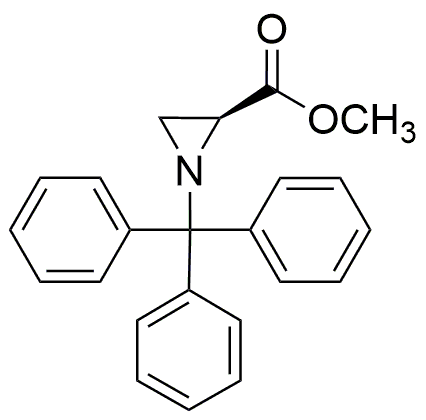Methyl (S)-(-)-1-tritylaziridine-2-carboxylate is widely utilized in research focused on:
- Pharmaceutical Development: This compound serves as a key intermediate in the synthesis of various pharmaceuticals, particularly in creating novel drugs with enhanced efficacy and reduced side effects.
- Organic Synthesis: It is employed in organic chemistry for constructing complex molecular architectures, allowing chemists to develop new compounds with specific properties.
- Chiral Catalysis: The compound is valuable in asymmetric synthesis, where it helps produce chiral molecules that are crucial in the production of many biologically active substances.
- Material Science: It can be used in the development of new materials, such as polymers and coatings, that require specific mechanical or chemical properties.
- Research in Neuroscience: This compound is being explored for its potential applications in neuropharmacology, particularly in the design of drugs targeting neurological disorders.
General Information
Properties
Safety and Regulations
Applications
Methyl (S)-(-)-1-tritylaziridine-2-carboxylate is widely utilized in research focused on:
- Pharmaceutical Development: This compound serves as a key intermediate in the synthesis of various pharmaceuticals, particularly in creating novel drugs with enhanced efficacy and reduced side effects.
- Organic Synthesis: It is employed in organic chemistry for constructing complex molecular architectures, allowing chemists to develop new compounds with specific properties.
- Chiral Catalysis: The compound is valuable in asymmetric synthesis, where it helps produce chiral molecules that are crucial in the production of many biologically active substances.
- Material Science: It can be used in the development of new materials, such as polymers and coatings, that require specific mechanical or chemical properties.
- Research in Neuroscience: This compound is being explored for its potential applications in neuropharmacology, particularly in the design of drugs targeting neurological disorders.
Documents
Safety Data Sheets (SDS)
The SDS provides comprehensive safety information on handling, storage, and disposal of the product.
Product Specification (PS)
The PS provides a comprehensive breakdown of the product’s properties, including chemical composition, physical state, purity, and storage requirements. It also details acceptable quality ranges and the product's intended applications.
Certificates of Analysis (COA)
Search for Certificates of Analysis (COA) by entering the products Lot Number. Lot and Batch Numbers can be found on a product’s label following the words ‘Lot’ or ‘Batch’.
*Catalog Number
*Lot Number
Certificates Of Origin (COO)
This COO confirms the country where the product was manufactured, and also details the materials and components used in it and whether it is derived from natural, synthetic, or other specific sources. This certificate may be required for customs, trade, and regulatory compliance.
*Catalog Number
*Lot Number
Safety Data Sheets (SDS)
The SDS provides comprehensive safety information on handling, storage, and disposal of the product.
DownloadProduct Specification (PS)
The PS provides a comprehensive breakdown of the product’s properties, including chemical composition, physical state, purity, and storage requirements. It also details acceptable quality ranges and the product's intended applications.
DownloadCertificates of Analysis (COA)
Search for Certificates of Analysis (COA) by entering the products Lot Number. Lot and Batch Numbers can be found on a product’s label following the words ‘Lot’ or ‘Batch’.
*Catalog Number
*Lot Number
Certificates Of Origin (COO)
This COO confirms the country where the product was manufactured, and also details the materials and components used in it and whether it is derived from natural, synthetic, or other specific sources. This certificate may be required for customs, trade, and regulatory compliance.


